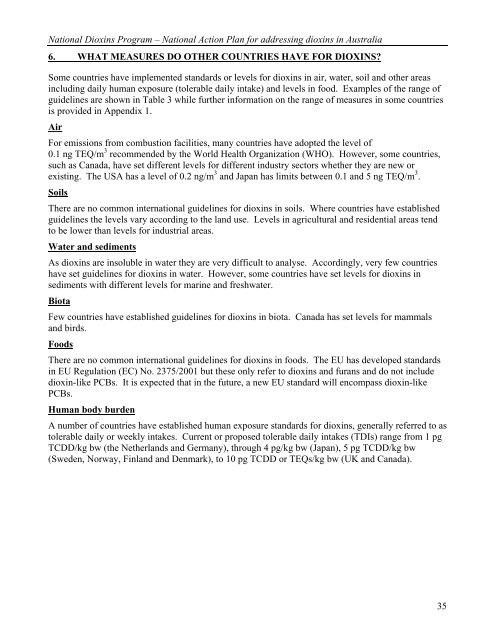National Action Plan for Addressing Dioxins in Australia
National Action Plan for Addressing Dioxins in Australia
National Action Plan for Addressing Dioxins in Australia
- No tags were found...
Create successful ePaper yourself
Turn your PDF publications into a flip-book with our unique Google optimized e-Paper software.
<strong>National</strong> <strong>Diox<strong>in</strong>s</strong> Program – <strong>National</strong> <strong>Action</strong> <strong>Plan</strong> <strong>for</strong> address<strong>in</strong>g diox<strong>in</strong>s <strong>in</strong> <strong>Australia</strong>6. WHAT MEASURES DO OTHER COUNTRIES HAVE FOR DIOXINS?Some countries have implemented standards or levels <strong>for</strong> diox<strong>in</strong>s <strong>in</strong> air, water, soil and other areas<strong>in</strong>clud<strong>in</strong>g daily human exposure (tolerable daily <strong>in</strong>take) and levels <strong>in</strong> food. Examples of the range ofguidel<strong>in</strong>es are shown <strong>in</strong> Table 3 while further <strong>in</strong><strong>for</strong>mation on the range of measures <strong>in</strong> some countriesis provided <strong>in</strong> Appendix 1.AirFor emissions from combustion facilities, many countries have adopted the level of0.1 ng TEQ/m 3 recommended by the World Health Organization (WHO). However, some countries,such as Canada, have set different levels <strong>for</strong> different <strong>in</strong>dustry sectors whether they are new orexist<strong>in</strong>g. The USA has a level of 0.2 ng/m 3 and Japan has limits between 0.1 and 5 ng TEQ/m 3 .SoilsThere are no common <strong>in</strong>ternational guidel<strong>in</strong>es <strong>for</strong> diox<strong>in</strong>s <strong>in</strong> soils. Where countries have establishedguidel<strong>in</strong>es the levels vary accord<strong>in</strong>g to the land use. Levels <strong>in</strong> agricultural and residential areas tendto be lower than levels <strong>for</strong> <strong>in</strong>dustrial areas.Water and sedimentsAs diox<strong>in</strong>s are <strong>in</strong>soluble <strong>in</strong> water they are very difficult to analyse. Accord<strong>in</strong>gly, very few countrieshave set guidel<strong>in</strong>es <strong>for</strong> diox<strong>in</strong>s <strong>in</strong> water. However, some countries have set levels <strong>for</strong> diox<strong>in</strong>s <strong>in</strong>sediments with different levels <strong>for</strong> mar<strong>in</strong>e and freshwater.BiotaFew countries have established guidel<strong>in</strong>es <strong>for</strong> diox<strong>in</strong>s <strong>in</strong> biota. Canada has set levels <strong>for</strong> mammalsand birds.FoodsThere are no common <strong>in</strong>ternational guidel<strong>in</strong>es <strong>for</strong> diox<strong>in</strong>s <strong>in</strong> foods. The EU has developed standards<strong>in</strong> EU Regulation (EC) No. 2375/2001 but these only refer to diox<strong>in</strong>s and furans and do not <strong>in</strong>cludediox<strong>in</strong>-like PCBs. It is expected that <strong>in</strong> the future, a new EU standard will encompass diox<strong>in</strong>-likePCBs.Human body burdenA number of countries have established human exposure standards <strong>for</strong> diox<strong>in</strong>s, generally referred to astolerable daily or weekly <strong>in</strong>takes. Current or proposed tolerable daily <strong>in</strong>takes (TDIs) range from 1 pgTCDD/kg bw (the Netherlands and Germany), through 4 pg/kg bw (Japan), 5 pg TCDD/kg bw(Sweden, Norway, F<strong>in</strong>land and Denmark), to 10 pg TCDD or TEQs/kg bw (UK and Canada).35
















